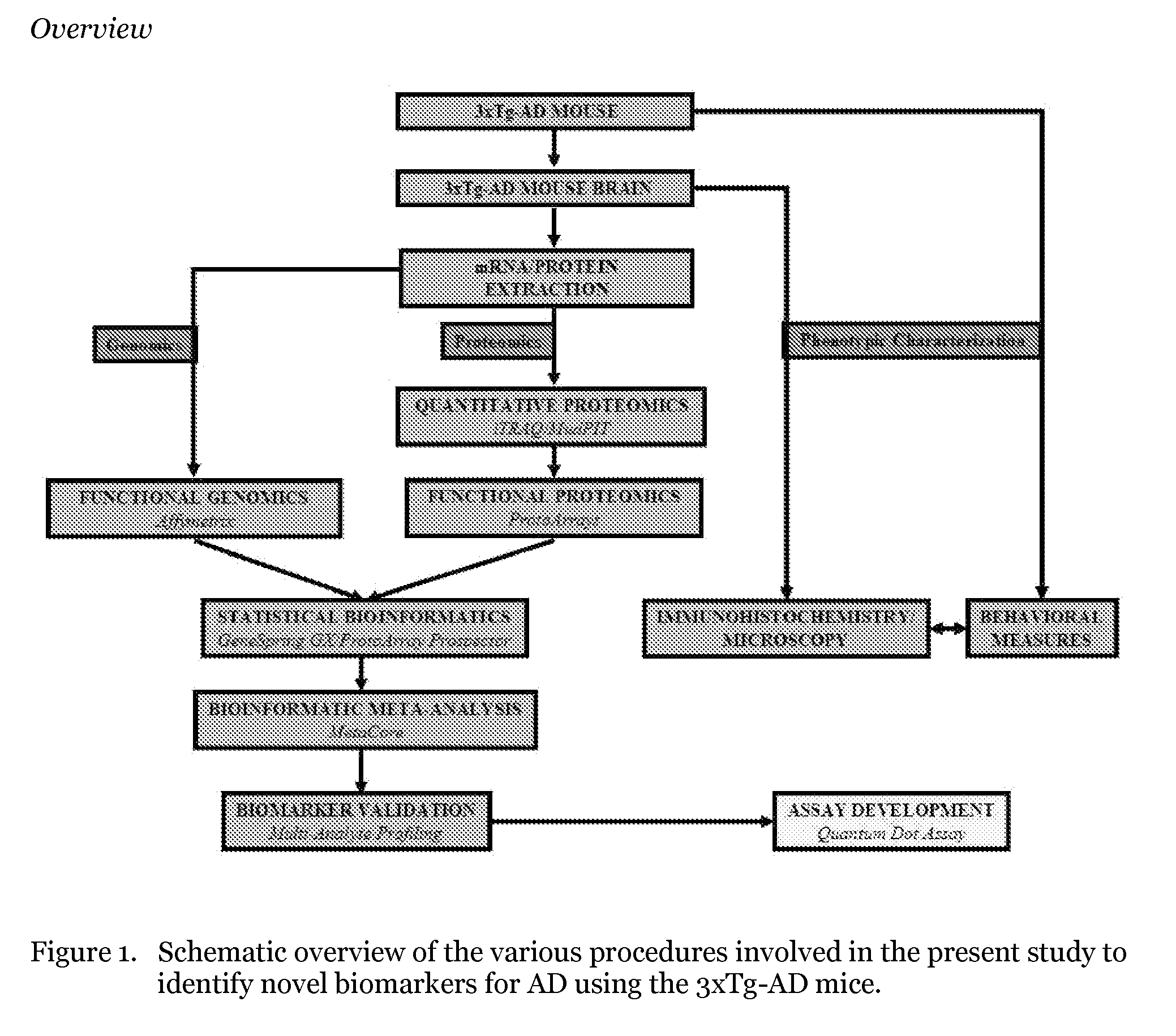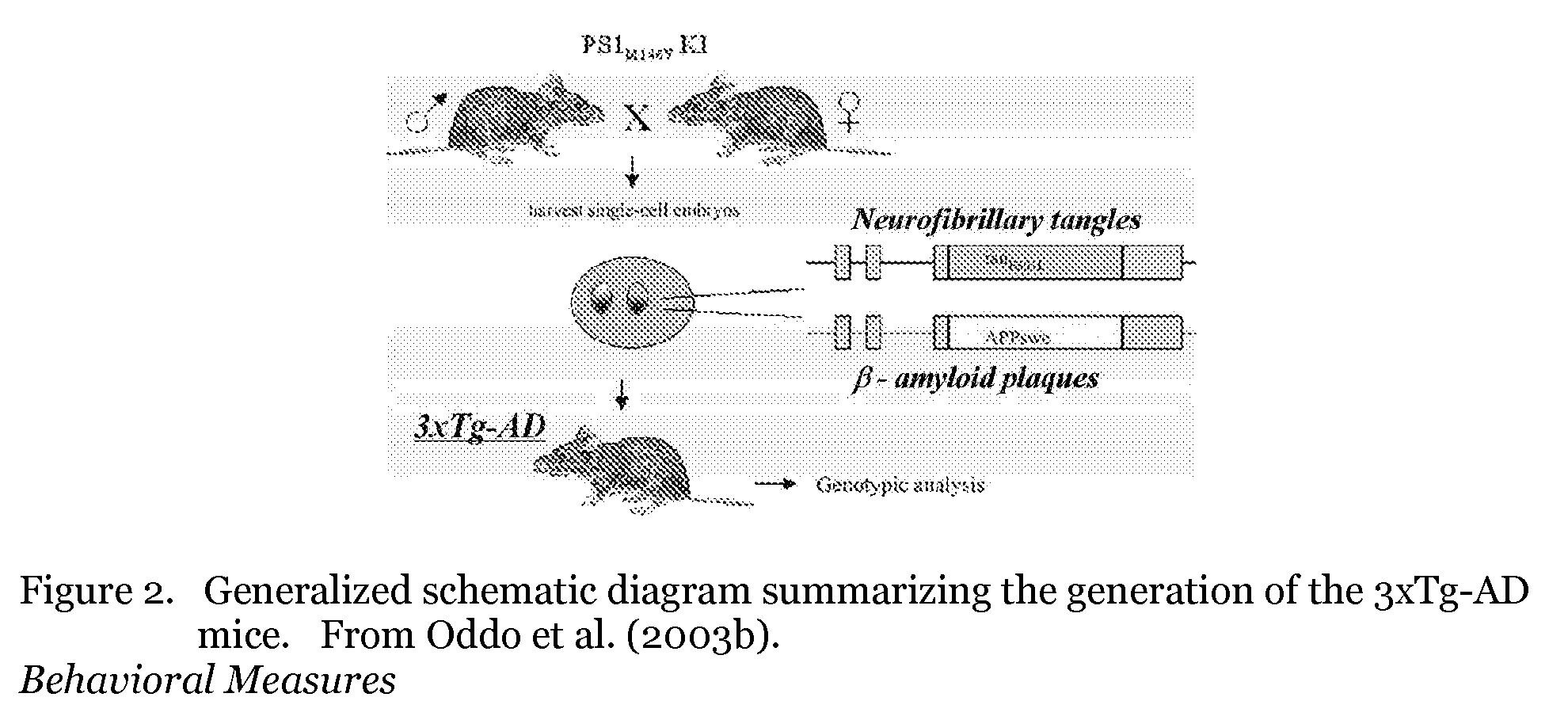Process for identification of novel disease biomarkers in mouse models of alzheimer's disease including triple transgenic mice and products thereby
a technology of alzheimer's disease and biomarkers, applied in the field of progressive neurodegenerative disorders, can solve the problems of not always the same relationship between the level of mrna and the level of protein end produ
- Summary
- Abstract
- Description
- Claims
- Application Information
AI Technical Summary
Benefits of technology
Problems solved by technology
Method used
Image
Examples
example 1
Mice and Surgical Procedures
[0030] Similar to the methodology described in Oddo et al. (2003a,b), 3xTg-AD harboring APPSwe, PS1M146V, and tauP301L transgenes, which were generated by simultaneous microinjection of two independent transgene constructs encoding human APPSwe (i.e., Swedish familial mutation) and tauP301L into the pronuclei of single-cell embryos harvested from mutant homozygous PS1M146V knockin mice. The PS1 knockin mice were originally generated on a hybrid 129 / C57BL / 6 background (Guo et al., 1999). Southern blot analysis of tail DNA is subsequently used to identify transgenic mice (LaFerla et al., 1995; Sugarman et al., 2002).
example 2
Behavioral Measures
[0031] Spontaneous Alternation Y Maze Task. As previously described (Holcomb et al., 1998), this learning paradigm involves hippocampal circuits that direct spatial working memory and bypasses the need for any training, reward, or punishment. The Y maze apparatus is comprised of three acrylic arms at 120° angles to one another. The dimensions of each arm are as follows: 40 cm length, 17 cm height, 4 cm width at the bottom and 13 cm width at the top. Each mouse, being placed in the center of the maze, is given 8 minutes to navigate through the maze freely. The sequence of entry and number of maze arms entered (entry defined as having all hind paws within the arm) is recorded. Percentage alternation is calculated as described in the above-mentioned literature.
[0032] Spatial Reference Morris Water Maze (MWM) Training. Mice are trained to swim to a submerged (and functionally invisible) 14 cm diameter circular clear Plexiglas platform. After being released from one ...
example 3
ELISA Quantitation of Brain Aβ Levels
[0033] After behavioral tests are completed as in Example 2, the Aβ1-40 and Aβ1-42 levels are measured using a sensitive sandwich enzyme-linked immunosorbent assay (ELISA) system (Duff et al., 1996; Miller et al., 2003). Frozen hemibrains are extracted in 0.2% diethlyamine with 50nM NaCl and centrifuged at 20,000×g for 1 hr at 4° C. to remove insoluble material. The resulting supernatant fractions are analyzed using the well-known BNT77 / BA27 and BNT77 / BC05 antibody systems to detect Aβ1-40 and Aβ1-42, respectively. These sandwich ELISAs are known to recognize both human and mouse Aβ1-40 and Aβ1-42 with equivalent sensitivities.
PUM
| Property | Measurement | Unit |
|---|---|---|
| Fluorescence | aaaaa | aaaaa |
Abstract
Description
Claims
Application Information
 Login to View More
Login to View More - R&D
- Intellectual Property
- Life Sciences
- Materials
- Tech Scout
- Unparalleled Data Quality
- Higher Quality Content
- 60% Fewer Hallucinations
Browse by: Latest US Patents, China's latest patents, Technical Efficacy Thesaurus, Application Domain, Technology Topic, Popular Technical Reports.
© 2025 PatSnap. All rights reserved.Legal|Privacy policy|Modern Slavery Act Transparency Statement|Sitemap|About US| Contact US: help@patsnap.com



